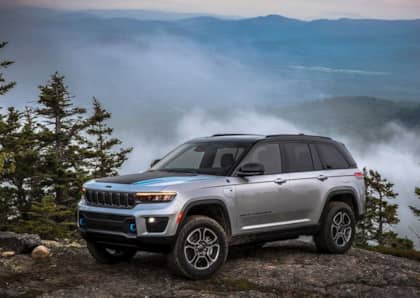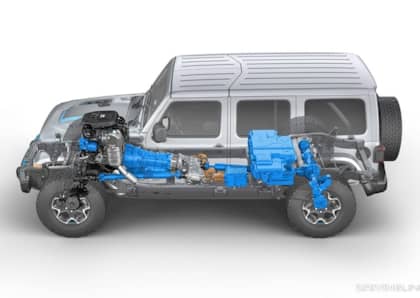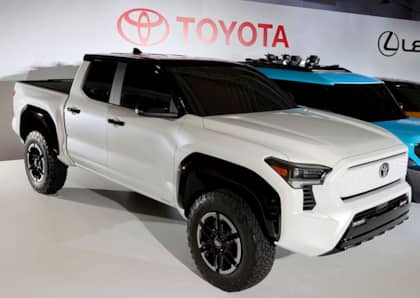The 2021 Jeep Wrangler 4xe Brings Hybrid Power To The Off-Road Masses: A Daily Driving Review
The 2021 Jeep Wrangler 4xe is a bit of a confusing engineering exercise. On the one hand the Wrangler represents one of the most simple designs on the SUV market, a full-frame truck riding on a pair of solid axles with a removable roof and doors that does its best to imitate its beyond-basic Jeep predecessors. On the other, the 4Xe's plug-in hybrid drivetrain attempts to drag the auto industry's favorite anachronism kicking and screaming into the electrified future.

With a one foot stuck in the past and the other stretching out into Tomorrowland, the Wrangler 4xe straddles a strange slice of the market. Is the Jeep aimed at that tiny percentage of hardcore off-road fans seeking a limited dose of all-electric driving, or is it an image-first option for lifestyle fans who love the Wrangler's rugged looks but want a little eco cred in the school pick-up line?

Unsurprisingly, it turns out that the answer to that question pulls from both sides of the aisle.
No Missing Ingredients
The 2021 Jeep Wrangler 4xe Rubicon doesn't leave out any of the details that have made it a darling among out-of-the-box four-wheel drive fans. Although available exclusively as a four-door, the battery-assisted Rubicon features the same 30 inches of water fording, rugged Dana 44 axles, 4:1 low-range crawl ratio, and rough-and-tumble suspension tuning required to survive a day of rock crawling as its gas or diesel-powered counterpart.

At the same time, you get a ton of extras—or make that a quarter-ton, because there's up to 700 lbs more curb weight associated with the 4xe's 17 kWh lithium-ion battery, electric motor, and associated wiring, all of which has been hidden away underneath the vehicle to protect it as much as possible from any errant off-road impacts. For those keeping score at home, that means the heaviest version of the hybrid Jeep tips the scales at a whopping 5,200 lbs.
It's Got Guts
Helping to haul that hefty load is a turbocharged, 2.0L four-cylinder engine that's paired with a 131hp electric motor (that also produces 184 lb-ft of torque). Together, the setup delivers 375 horses and 470 lb-ft of twist, with the latter figure matching the distinctly non-eco Wrangler 392 V8.

This doesn't make the Wrangler hybrid a hot rod, but it does provide solid acceleration in almost every circumstance, complementing what was already the best engine on the vehicle's order sheet with great big gobs of instant-on torque. Unfortunately, there's a price to be paid for this level of performance, and it comes in the form of fairly dismal fuel economy (49 MPGe with the battery full, and about 20-mpg combined with it empty, which is low even in Wrangler country).

How can a plug-in hybrid let you down at the fuel pump? It's a simple calculus: add in the weight of the drivetrain and the big battery, and unless you're regularly topping off electrons the electric motor doesn't do much to offset the rolling mass. This same weight penalty is reflected in the 4xe's somewhat dismal 21 miles of EV operation on a full charge, a number that will probably get you to work in the morning but won't likely help you on your way home if you can't find an outlet in the parking lot.

Charging infrastructure being what it is, there's no guarantee that even if you do locate a plug that it will be available or even functional, which further limits the Wrangler 4xe's electric abilities. This is doubly true for trail driving—low-range four-wheel drive works just as well in EV mode as it does with the gas engine kicking, but good luck sourcing an extension cord long enough to reach all the way back to base camp.
Full EV, Full Weird
There's a certain novelty associated with sailing the Wrangler hybrid down the road under a cloud of silence, with only the knobby rubber and ever-present wind noise assailing your ear drums with EV mode engaged.

You can even choose E-Save mode to preserve battery charge (or even use the gas engine to fill it up while cruising) on an extended highway drive (although I wasn't able to push the battery charge up past 1 percent once emptied using either E-Save or the aggressive MAX REGEN one-pedal drive mode).

You also get more than the usual share of attention when plugging the Jeep in at a public charging station. There's a certain cognitive dissonance in seeing this kind of beast tethered to the shape of things to come by a thick wire attached to a lighted pole on the side of the road, almost like putting headlights on a horse. Be prepared for questions and comments as the world around you struggles to catch up with the Wrangler's progress.
Different Strokes
It's hard to say whether the Wrangler 4xe is a smart buy or not. There's no doubt that the complexity of the vehicle's various systems is enough to give one pause from a reliability perspective, especially if part of your attraction to the Jeep has to do with its reputation for simplicity. How well the 4xe will stand up to repeated off-road abuse is anyone's guess at this point.

Then there's the cost. While the cheapest version of the 4xe starts at just under $50,000 and runs to $55k for the High Altitude trim (with the Rubicon splitting the difference), it does come with a $7,500 federal tax credit to help ease some of the burden. With that credit in the picture it's possible for the plug-in hybrid Wrangler to undercut a gas-powered model depending on what options have been ordered.

Perhaps the most interesting aspect of the 4xe's existence is that it underscores just how much the Wrangler family has grown over the past decade. It's easy to forget that Jeep's most popular model was once restricted to thirsty, low-powered six-cylinder engines, but now boasts a V8, a turbodiesel, a V6, and a turbo four alongside the plug-in hybrid model (and of course two-door, four-door, and Gladiator pickup body styles). If you do decide that the 4xe's (brief) silent running isn't for you, there are still a half-dozen alternatives available to keep you in the Wrangler fold.











